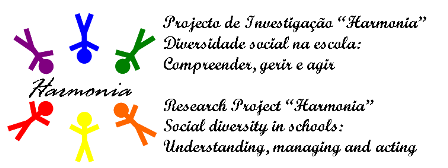Drawing on the Contact Hypothesis (Allport, 1954) and on Social Identity theory (Tajfel, 1982) this research project focuses on two main issues that are theoretically and socially paramount in current Developmental Social Psychology
1) The developmental course of prejudiced attitudes and behaviours in dominant White groups against minority stigmatised groups. The more puzzling issue regarding prejudice development is the ‘format’ of its course. Whereas the mainstream developmental approach on this topic (Aboud, 1988) states that changes in children’s cognitive abilities account for an alleged decline of prejudice since middle childhood, the socio-normative approach (França & Monteiro, 2004; Rutland et al., 2005) argues that current social norms regarding ethnic prejudice are key factors in the development of in-group favouritism and out-group derogation. In addition, it states that the absence of discriminatory attitudes in children since 7 years old is the effect of the anti-racist norm pressure, which only affects overt, but not covert, expressions of prejudice, as much in childhood as later on. In order to test the interplay of normative pressure and children’s cognitive abilities in children’s overt and indirect expressions of prejudice towards minority peer-groups, two experimental studies were designed using both explicit and implicit measures to assess ethnic prejudice. The use of implicit measures will allow uncovering the controversial effects of normative pressure and of audience on children’s expressions of prejudice. Moreover, in order to bring to light processes accounting for phenomena under research, cognitive (meta-perceptions of inter-group bias inhibition behaviour) and socio-cognitive (perception of the anti-racism norm and perspective-taking ability) competencies recruited for children’s self and contextual management of reported inter-group bias will be included in the designs. They are hypothesised to be potential mediators and moderators of audience and normative pressure effects on expressions of ethnic prejudice in different developmental stages.
2) The moderating role of groups’ status in intergroup prejudice reduction and in the generalisation of positive change to the out group as a whole.
It is now clear that migratory movements should be more carefully managed integrating information about cultural diversity. In line with this concern, the social psychology of intergroup relations has since long developed and tested models to reduce negative effects of intergroup categorisation on adult life conflicts and discrimination (Allport, 1954; Gaertner & Dovidio, 2000). The topic of reducing intergroup prejudice in children using SIT’s framework only very recently has drawn the attention of researchers in the social psychology area and so it remains unclear which is the pattern of recategorization that can better reduce or even eliminate children’s inter-ethnic prejudiced behaviour. In line with previous research (Rebelo et al., 2005), three studies will experimentally test the relative efficacy of two models of prejudice reduction – Common In-group Identity (CII) and Dual Identity (DI)(Gaertner & Dovidio, 2000) - between unequal-status groups within and beyond a contact situation. In order to identify the mediating processes and the moderating variables accounting for the differential effects of these models on the reduction of inter-ethnic prejudice and on the generalisation of positive intergroup attitudes to the out-group as a whole, group-status asymmetry (Black and White groups), groups’ prototypicality and perceived distinctiveness will be analysed. Groups’ perceived distinctiveness is relevant for the dissimilar expected effects of Common In-group Identity and Dual Identity: while in the first recategorization induces the representation one super ordinate-inclusive group and the blurring of the initial group boundaries, in the last one recategorization is directed to the representation of the two groups as one super ordinate-inclusive group together with the maintenance of the initial groups’ boundaries. Group distinctiveness thus becomes the crucial difference between the two models and is expected to account for prejudice reduction against the minority, but not against the dominant group. The generalization of positive attitude change subsequent to manipulations of intergroup representation during interaction is a theoretical and empirical relevant topic, since school-based intervention programmes will certainly benefit from a better understanding of both the immediate power of these models to reduce inter-ethnic conflict and discrimination and their mid and long term potential effects.
On the whole these studies aim to enlarge the understanding of prejudice development and reduction in childhood and to bring to light processes accounting for overt and covert expressions of intergroup discrimination between unequal status children.

